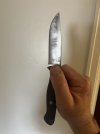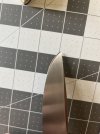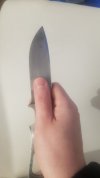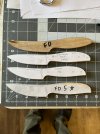- Joined
- Oct 18, 2018
- Messages
- 8,455
Very Nice....
Your finished knife looks more like FD than FD3?
Your finished knife looks more like FD than FD3?
The BladeForums.com 2024 Traditional Knife is available! Price is $250 ea (shipped within CONUS).
Order here: https://www.bladeforums.com/help/2024-traditional/
Exactly right sir! I still go back and forth on which one I like more but they’re pretty similarVery Nice....
Your finished knife looks more like FD than FD3?
I guess I’m not quite sure what you mean. This knife hasn’t been sharpened yet, and is sitting at about .006” with a little more meat leading up to the tip
I see what you guys are saying and am welcome to the comments. This is just a design based off my opinions and use.Long bellies are good for simple steels with low edge retention so it makes more contact per stroke, thus prolonging sharpness. Short belly with carbide steels get more action done per same stroke. Pinch blade grip resolves any issues with finger clearance. Of course, 100 people, 100 opinions. Probably all agree that the thickness and sharpening angle of the blade will determine usability more than blade shape.
Looking back at the pictures, I can see, and agree with this. Short, accurate mini slices, vs. long sweeping cuts (depending on the steel)Long bellies are good for simple steels with low edge retention so it makes more contact per stroke, thus prolonging sharpness. Short belly with carbide steels get more action done per same stroke. Pinch blade grip resolves any issues with finger clearance. Of course, 100 people, 100 opinions. Probably all agree that the thickness and sharpening angle of the blade will determine usability more than blade shape.
I was thinking about your comment a little more on the steels.Long bellies are good for simple steels with low edge retention so it makes more contact per stroke, thus prolonging sharpness. Short belly with carbide steels get more action done per same stroke. Pinch blade grip resolves any issues with finger clearance. Of course, 100 people, 100 opinions. Probably all agree that the thickness and sharpening angle of the blade will determine usability more than blade shape.
Also to elaborate more on your pinch grip, for that to be true and totally eliminate your fingers under the handle, you’d have to hold the knife like this. I’ve never held a knife like that before when field dressingLong bellies are good for simple steels with low edge retention so it makes more contact per stroke, thus prolonging sharpness. Short belly with carbide steels get more action done per same stroke. Pinch blade grip resolves any issues with finger clearance. Of course, 100 people, 100 opinions. Probably all agree that the thickness and sharpening angle of the blade will determine usability more than blade shape.

I just wanted point this out too, these knives have the same belly line. What may throw you off to thinking they’re not the same is the straight edge of the drop point pronounces the belly more, but they’re nearly identical. (Top is my pattern)I prefer the one you marked “standard drop point” better than the one labeled “my pattern”
Your pattern looks like a standard drop point that has had its belly worn away.
On the standard drop point picture. The area marked in red is the area I’m calling the belly it’s the part I use most for skinning.

Yes. I actually really liked your comment on cutting above the waist versus below. I always refer back to it in my mindI bet that slices well and gives decent knuckle/handle clearance. This is intended for skinning or field dressing game on the ground, right?
Looks good to me.
Yes. I actually really liked your comment on cutting above the waist versus below. I always refer back to it in my mind
I just wanted point this out too, these knives have the same belly line. What may throw you off to thinking they’re not the same is the straight edge of the drop point pronounces the belly more, but they’re nearly identical. (Top is my pattern)
View attachment 2117139
Also to elaborate more on your pinch grip, for that to be true and totally eliminate your fingers under the handle, you’d have to hold the knife like this. I’ve never held a knife like that before when field dressing
View attachment 2117137

Depends on your skill how deep a cut at skinning you can handle. Too deep and there is lack of control what is cut. I see mostly people use more shallow cuts than a few deeper ones. Many people, many ways. In the end it's just a choice.I was thinking about your comment a little more on the steels.
If simple steels lend themselves to a longer belly, and high carbide steels do the same work in a shorter belly, why not just make the high carbide steels also have the longer belly line? Is there some advantage to having a short belly? Maybe I’m missing something
Interesting take. I don’t disagree and think a lot of it is personal preference. I just haven’t held the knife much like that when field dressingDepends on your skill how deep a cut at skinning you can handle. Too deep and there is lack of control what is cut. I see mostly people use more shallow cuts than a few deeper ones. Many people, many ways. In the end it's just a choice.


Nice. Handles that arc up and let you tuck your fingers up into it help as well (like that swamp rat).Great thread. I would actually love to try this blade ^. For clarification, is this is your FD3?deerrockknives
The best field-dressing knife I own, a modified Swamp Rat......



Basically what I’m saying is this: I feel knives that put your knuckles more in line with the edge are far superior for game processing.

Late to this thread, but I thought the same way for a long time.....until I recently discovered the ideal camp/food/game-processing knife (for me).
The offset handle of this knife takes all the strain off the wrist when making harder cuts, and allows your forearm (with its bigger muscles) to do most of the work. A straightline knife/handle does not allow nearly the same versatility and flexability as a pistol-grip.
This knife is - by far - the most efficient design I have used in over 40 years of skinning/butchering game. It makes both push and pull cuts effortless because of the mechanical advantage of the offset.
I truly wish I had discovered this 40 years ago (Mineral Mountain Hatchet Works):

